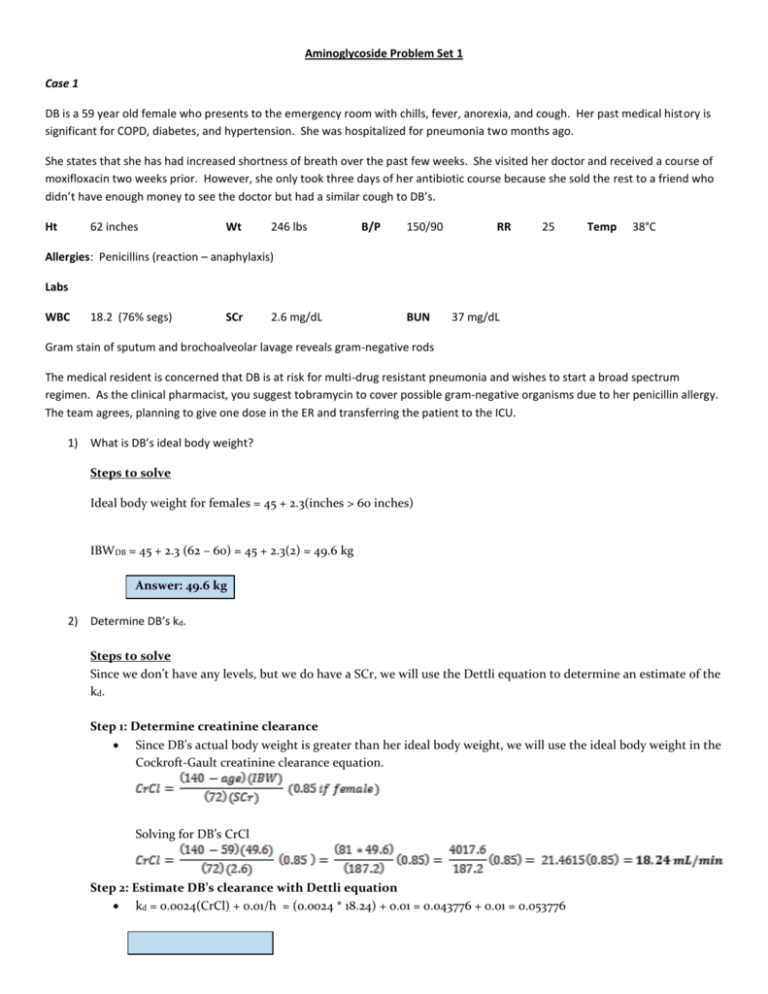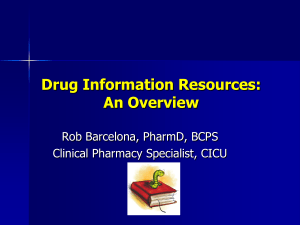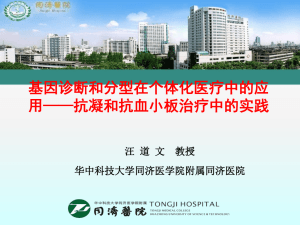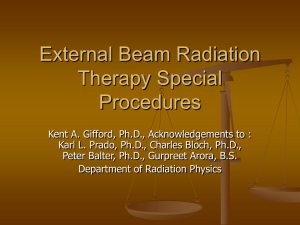Answers to Problem Set 1
advertisement

Aminoglycoside Problem Set 1 Case 1 DB is a 59 year old female who presents to the emergency room with chills, fever, anorexia, and cough. Her past medical history is significant for COPD, diabetes, and hypertension. She was hospitalized for pneumonia two months ago. She states that she has had increased shortness of breath over the past few weeks. She visited her doctor and received a course of moxifloxacin two weeks prior. However, she only took three days of her antibiotic course because she sold the rest to a friend who didn’t have enough money to see the doctor but had a similar cough to DB’s. Ht 62 inches Wt 246 lbs B/P 150/90 RR 25 Temp 38°C Allergies: Penicillins (reaction – anaphylaxis) Labs WBC 18.2 (76% segs) SCr 2.6 mg/dL BUN 37 mg/dL Gram stain of sputum and brochoalveolar lavage reveals gram-negative rods The medical resident is concerned that DB is at risk for multi-drug resistant pneumonia and wishes to start a broad spectrum regimen. As the clinical pharmacist, you suggest tobramycin to cover possible gram-negative organisms due to her penicillin allergy. The team agrees, planning to give one dose in the ER and transferring the patient to the ICU. 1) What is DB’s ideal body weight? Steps to solve Ideal body weight for females = 45 + 2.3(inches > 60 inches) IBWDB = 45 + 2.3 (62 – 60) = 45 + 2.3(2) = 49.6 kg Answer: 49.6 kg 2) Determine DB’s kd. Steps to solve Since we don’t have any levels, but we do have a SCr, we will use the Dettli equation to determine an estimate of the kd. Step 1: Determine creatinine clearance Since DB’s actual body weight is greater than her ideal body weight, we will use the ideal body weight in the Cockroft-Gault creatinine clearance equation. Solving for DB’s CrCl Step 2: Estimate DB’s clearance with Dettli equation kd = 0.0024(CrCl) + 0.01/h = (0.0024 * 18.24) + 0.01 = 0.043776 + 0.01 = 0.053776 Answer: kd = 0.0537 h-1 3) What is DB’s anticipated half-life of tobramycin? Steps to solve t1/2 = ln 2/ kd t1/2 = 0.693/ 0.0537 = 12.88895 Answer: 12.9 h 4) What dose would you recommend for DB based on a 2 mg/kg/dose? Steps to solve Since we know that DB’s actual body weight is greater than her ideal body weight, we need to determine if we should use an adjusted dosing weight. Step 1: Determine if ABW > 30% of IBW ABW = 246 lbs/2.2 = 111.8 kg IBW = 49.6 kg 111.8/49.6 = 2.25 greater than 30% (225% greater) Step 2: Determine dosing weight DW = LBW + 0.4(ABW – LBW) = 49.6 + 0.4(111.8 – 49.6) = 49.6 + 0.4(62.2) = 49.6 + 24.88 = 74.48 kg Step 3: Determine 2 mg/kg dose Dose = (2)(74.48) = 148.96 Rounded to 140 mg Answer: 140 mg Two days later, you review DB’s progress. You see that she has been receiving a tobramycin dose of 120 mg q12h. She has been showing improvement in treatment and her serum creatinine has slightly improved. You request tobramycin levels with the next dose to ensure adequate dosing. Tobramycin Tobramycin 2.9 mg/L @ 0730 7.6 mg/L@ 1030 After checking the medical administration record, you see that tobramycin doses are given at 0900 and 2100. Per hospital policy all aminoglycosides are infused over 1 hour. 5) What is DB’s new kd, calculated from the tobramycin levels drawn? Steps to solve Since we have actual levels for DB, we can use the patient specific trough and peak data to tailor DB’s dosing regimen. 7.6 mg/L 2.9 mg/L 0730 2.9 mg/L 0900 1030 1930 Step 1: Since DB is at steady state, we can extrapolate the level taken at 0730 to 1930 to use that to determine k d. Step 2: Determine the actual time between 1030 and 1930 = 9 h Step 3: Use data to find kd Alternate way 1 2.9 = 7.6e-( Alternate way 2 x 9) = - 0.107048612 Answer: -0.107 6) Determine DB’s extrapolated peak and trough concentrations. Steps to Solve Step 1: Determine extrapolated peak = - 0.107048612 4 factors to consider o When was dose given? 0900 o For how long was the drug infused? 1 hour o When was the post-dose level taken? 1030 o What was the post-dose level? 7.6 mg/L Since the dose was given at 0900 and infusion time was 1 hour, the extrapolated (true) peak was at 1000. The time between the extrapolated peak and the post-dose level was 0.5 hours. = 8.01767137 mg/L Step 2: Determine extrapolated trough 3 factors to consider o What was the pre-dose level? 2.9 mg/L o When was the pre-dose level taken? 0730 o When was the dose given? 0900 The extrapolated (true) trough is exactly at the time when the next dose is given, i.e. 0900. The time between the pre-dose level and extrapolated trough is 1.5 hours. Answers: Extrapolated peak = 8.02 mg/L; extrapolated trough = 2.47 mg/L 7) What is DB’s Vd? Steps to solve Knowns o Dose = 120 mg o tinf = t’ = 1h o kd = 0.107 o Cmax = 8.02 o Cmin = 2.47 Answer: 19.6 L 8) What is DB’s new half-life? Steps to solve t1/2 = ln 2/ kd = 0.693/0.107 = 6.476635514 Answer: 6.5 h After consulting with the team, you decide to adjust DB’s dose. You calculate your dose and round it to the nearest 20 mg; your suggestion to the team is a dose of 260 mg q24h, resulting in a peak of 13.6 mg/L and trough of 1.2 mg/L. The attending, however, disagrees with you and wishes to target a higher peak, per his experience with higher peaks in cystic fibrosis patients. By his calculations, he says the patient should receive 340 mg q24h. 9) Using the physician’s new dosing regimen, what will DB’s new peak and trough be? Steps to solve Step 1: Determine the ratio of the physician’s dose to your dose Your dose = 260 mg Physician’s dose = 340 mg Ratio = 340/260 = 1.307692308 The levels should increase by a factor of 1.3 Step 2: Determine new peak (13.6) x (1.3) = 17.78 round to 17.8 mg/L Step 3: Determine new trough (1.2) x (1.3) = 1.56 round to 1.6 mg/L Answer: New peak = 17.8 mg/L; new trough – 1.6 mg/L Case 2 RJ is a 36 year old man admitted to the ICU due to injuries sustained in a motor vehicle accident. After 8 days in the ICU, RJ has developed a worsening fever, and his O2 saturation dropped to 85%. Chest X-rays reveal a diffuse infiltrate in the right lower lobe. RJ is started on broad spectrum antibiotics including tobramycin. The physician consults you, the clinical pharmacist, regarding therapeutic drug monitoring. Ht: 72 inches Wt: 70 kg Temp: 101.8°F WBC : 18,000 cells/mm3 SCr : 1.6 mg/dL 1) What is RJ’s calculated creatinine clearance? Steps to solve Step 1: Determine RJ’s ideal body weight. IBW = 50 + 2.3(12) = 77.6 kg ABW < IBW, so use ABW to calculate CrCl Step 2: Determine RJ’s CrCl. Answer: 63.19 mL/min 2) What is RJ’s estimated kd? Steps to solve Estimate DB’s clearance with Dettli equation kd = 0.0024(CrCl) + 0.01/h = (0.0024 * 63.19) + 0.01 = 0.151656 + 0.01 = 0.161656 Answer: 0.161 h-1 3) What loading dose would you give RJ based on a 2mg/kg/dose? Round to the nearest 20 mg. Steps to solve Determine RJ’s dose based on actual body weight. Dose = 2 mg/kg * 70 kg = 140 mg Answer: 140 mg The next day, on rounds, RJ seems to have improved and his SCr has improved (now 1.3 mg/dL). You see that he has gotten one dose of tobramycin (scheduled as 160 mg q8h). You decide to draw levels around the second dose to ensure he is getting adequate dosing. 0745: 0.8 mg/L 0800 – 0830: 160 mg infused 0915: 7.8 mg/L 1445: 1.7 mg/L 4) What is RJ’s new kd? Steps to solve Step 1: Determine kd. Because this kinetic study is done around the second dose, we need to consider that RJ is not at steady state. Therefore, we use the levels taken at 0915 and 1445 to determine the kd as opposed to flipping the 0.8 mg/L trough taken 15 minuets at 0745. Answer: - 0.277 h-1 5) What are RJ’s true peak and trough concentrations? Steps to solve Step 1: Determine Cmax Infusion over at 0830 and dose given at 0915, so time between is 45 minutes or 0.75 hours C = Cmaxe(-kt) 7.8 = Cmax e (-0.277 * 0.75) 7.8 = Cmax (0.812410113) Cmax = 9.601062157 Step 2: Determine Cmin Because RJ is not at steady state, we need to use the trough level taken as 0.8 mg/L to determine the C min. The dose is given at 0800 and the level was taken at 0745, so time between is 15 minutes or 0.25 hours Cmin = 0.8e(-0.277*0.25) Cmin= 0.8 (0.933093377) Cmin = 0.74647402 Answer: Cmax = 9.6 mg/L; Cmin = 0.75 mg/L 6) What is RJ’s Vd? Steps to solve Knowns: Cmax = 9.6 Cmin = 0.75 kd= -0.277 tinfusion = 0.5h Dose = 160 mg Answer: 16.7 L You consult with the physician about changing RJ’s dose based on your kinetic studies. He wants you to target a peak of 8 mg/L and a trough of 0.75 mg/L or less. Hospital policy is to infuse over an half-hour. 7) What dosing interval do you recommend? Steps to solve Knowns Cmax = 8 mg/L Cmin = 0.75 mg/L tinfusion = 0.5 h kd= -0.277 ) + 0.5 = 9.0455 round to 12 h Answer: 12 hours 8) What dosage would you recommend? Round the dose to the nearest 20 mg. Steps to solve Knowns kd=0.277 tinf = 0.5h Cmax = 8 mg/L Vd = 16.7 L T = 12h = (0.277)(0.5)(16.7)(8) = Answer: 140 mg 9) What are the expected peak and trough concentrations from your dosing regimen? Steps to solve Step 1: Cmax Step 2 : Cmin Cmin = 8.12e(-0.277*11.5) = 0.335 mg/L Answer: Cmax = 8.12 mg/L; Cmin = 0.33 mg/L Case 3 RD, a 27 year old female, has been admitted for an infected abscess on her right arm secondary to IV drug use. Her past medical history includes a HIV+ diagnosis (current CD4 count of 240) and previous admissions for bacteremia/possible endocarditis. She admits that she frequently uses stagnant water to wash her needles. Upon admission, she initially complained of redness, swelling at the injection site, and slight pain (2 or 3 out of 10, 1 being the least, 10 being the most pain) but did not have a fever. Abscess cultures taken at admission revealed Pseudomonas aeruginosa, sensitive to piperacillin/tazobactam, cefepime, carbapenems, and aminoglycosides; no growth was positive in 2/2 blood cultures. However, now, three days later, there is increased redness and swelling as well as pus production and intermittent fevers. Her pain is now an 8 or 9 out of 10. Her drug regimen has consisted of piperacillin/tazobactam 3.375g q8h, tobramycin 300mg q24h, and vancomycin 500 mg q12h. Blood cultures taken early this morning revealed gram negative rods in 2/2 bottles. Ht 64 inches Wt 115 lbs WBC 18.2 (76% segs) SCr 0.6 mg/dL Temp 38.7°C The medical team has stopped the vancomycin after abscess cultures, but they still wish to continue double coverage for P. aeruginosa. You tell the team you are concerned that the drug dosing of the piperacillin/tazobactam and tobramycin is not adequately covering the P. aeruginosa. You suggest increasing the dose of piperacillin/tazobactam to 3.375 g q6h and tell them you are going to check tobramycin levels, since you suspect that RD’s clearance is too fast for once daily dosing. The following levels are drawn. 0830 levels undetectable (< 0.02 mg/L) 1030 17.0 mg/L 1430 3.2 mg/L Per hospital policy, all aminoglycosides are administered over 1 hour. RD’s dose is given at 0900. 1) Based on the levels drawn, what is RD’s calculated half-life? Steps to solve Step 1: Determine RD’s kd. Since RD has received at least three doses, we can assume she is at steady state. We can use the series of levels to determine her kd. C = Co e-kt 3.2 = 17.0 e-k(4) k = 0.417515633 Step 2: Determine RD’s t1/2. t1/2 = ln (2) / kd = 0.69314718/0.417515633 = 1.660170604 Answer: 1.7 hours 2) What is RD’s extrapolated peak concentration? Steps to solve RD’s dose was given at 0900 and infused over an hour; therefore, RD’s peak occurred at 1000. 17.0 = Coe(-0.418)(0.5)= Co e-0.209 = Co(0.811395235) Co = 20.95156497 Answer: 21.0 mg/L 3) What is RD’s Vd? Steps to solve We have all the necessary data except the Cmin If we use our exponential concentration equation, we can determine the actual Cmin o C = Coe-kt = 20.95156497e-(.418*23) = 0.001399 mg/L Alternatively, since we know the trough level is undetectable, we can estimate the C min is 0 mg/L. Knowns Dose = 300 mg tinf = 1 hour k = 0.417516 h-1 Cmax = 20.95156497 mg/L Cmin ≈ 0 mg/L = = = Answer: 11.7 L 4) Based on RD’s calculated parameters, what dosing regimen would recommend? The team wishes to target at peak of 10 mg/L and a trough of 1 mg/L or less. Round your answer to the nearest 20 mg. Steps to solve Step 1: Determine dosing interval Knowns Cmax = 10 mg/L Cmin = 1 mg/L tinfusion = 1 h kd= -0.418 Round to 8 hours Step 2: Determine dose Knowns kd=0.418 tinf = 1h Cmax = 10 mg/L Vd = 11.7 L T = 8h = 48.906 * = = 138.0990117 Answer: 140 mg q8h 5) What are your expected peak and trough concentrations? Steps to solve Step 1: Cmax Step 2 : Cmin Cmin = 10.14e(-0.418*7) = 0.543616088 mg/L Answer: Cmax = 10.14 mg/L; Cmin = 0.54 mg/L 6) When would you schedule the next dose? You decide to let the concentration go below 1 mg/L before you redose. Steps to solve Since we know that the level at 1430 was 3.2 and RD’s kd = 0.418, we can determine when the concentration will be less than 1.0. 1.0 = 3.2e-(0.418*t) t = 2.78265 If we round t to 3 (since the level will be less than 1 at that point), we will dose 3h from 1430. Answer: 1730 7) When would you consider re-checking levels? Answer: If you desired to re-check levels, you would wait until around the third or fourth dose when RD is at steady state with her new dosing schedule. Whether you do or do not take levels would depend on RD’s progress as well as if there are any other factors in her clinical status that would have an effect on aminoglycoside clearance (e.g. decrease in renal function). (If RD’s clinical status would rapidly decline to sepsis and RD required movement to the ICU, it might be useful to check her aminoglycoside concentrations prior to the third dose.)








